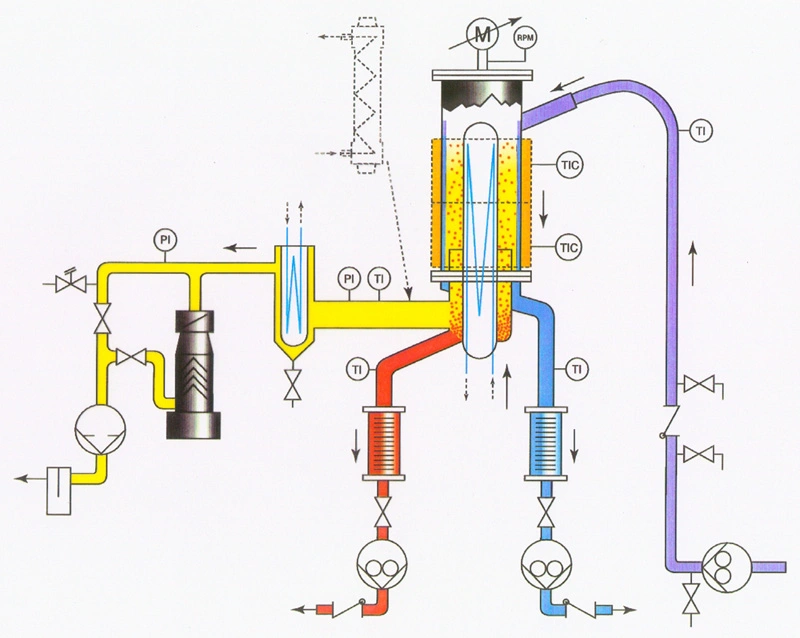Keys To The Success Of Pope Scientific’s Wiped-Film Stills
 Distillation is one of the most important means of separation and purification of liquids in chemical processing. In a mixture of different chemicals, the various components will have differing characteristics, including physical properties such as levels of volatility. A component with greater volatility than another (or “lighter” than the other), will boil at a lower temperature than the other. If the mixture is maintained at a temperature in between the boiling points (BP) of two components, the lighter component will vaporize while the heavier component(s) will not. If a surface (condenser), is placed in the vapor space and is kept cooler than any of the boiling points, the vapor will condense and can be collected as a liquid distillate with a composition having a greater percentage of the lighter component. The BP’s can be reduced by lowering the prevailing pressure, thus vacuum conditions are often used.
Distillation is one of the most important means of separation and purification of liquids in chemical processing. In a mixture of different chemicals, the various components will have differing characteristics, including physical properties such as levels of volatility. A component with greater volatility than another (or “lighter” than the other), will boil at a lower temperature than the other. If the mixture is maintained at a temperature in between the boiling points (BP) of two components, the lighter component will vaporize while the heavier component(s) will not. If a surface (condenser), is placed in the vapor space and is kept cooler than any of the boiling points, the vapor will condense and can be collected as a liquid distillate with a composition having a greater percentage of the lighter component. The BP’s can be reduced by lowering the prevailing pressure, thus vacuum conditions are often used.
For simple molecules such as low molecular weight solvents, the temperature and the duration of the time of exposure to elevated temperature is typically not critical, in other words, prolonged boiling times, will not degrade these chemicals due to their thermal stability. However, there exist chemicals of very high BP’s and molecular weights (MW) that are prone to chemical degradation by cracking, reacting or polymerizing. These cannot survive the required elevated boiling temperatures for extended periods. The degradation effect is enhanced with increased temperatures, but often overlooked is the effect of the duration of time of the exposure to heat, which when extended, can cause far more degradation than the temperature level itself.
For these delicate materials, a special distillation technique is required. The technique must include; provision for a very short period of heat exposure, a highly efficient mechanism to allow sufficient evaporation to occur within this short period, and high vacuum capability to reduce the extreme boiling points of the components. Pope wiped-film stills are specially designed to include these and other important features.
Wiper Diagram

Wiped-Film Distillation Process
Feed liquid is continuously fed onto the inner wall of a heated vertical cylinder where it is immediately spread evenly as a thin film by rotating wipers around and down the cylinder. The wipers are specially designed with diagonal slots, each of which causes a highly turbulent micro-mixing of the film. This dynamic causes a high degree of mass and heat transfer to take place, quickly heating the liquid and greatly increasing the effective surface area of the liquid-vapor interface, necessary for allowing the more volatile molecules to escape and vaporize rapidly from the liquid, (as opposed to being held back from reaching the interface by significant depths of liquid as is the case in, for example, a batch mode boiling vessel). It is this efficiency that allows even high percentages of volatiles to evaporate within a matter of only seconds of travel in the cylinder. The less volatile, heavier components don’t evaporate and remain as a liquid, leaving quickly out of bottom of the heated cylinder as residue.
Heated walls (orange) and high vacuum (yellow) drive the more volatile components (distillate) to the closely positioned internal condenser as the less volatile components (residue) continue down the cylinder. The resulting fractions from high vacuum distillation separate, and then exit through individual discharge outlets. Depending on the application, the desired product is either the distillate or the residue fraction. Small amounts of condensable low MW compounds collect in cold trap upstream of the vacuum system. For high solvent loads, an optional external condenser may be installed immediately.
The success of the wiped film technique is further enhanced by other special design features including capabilities of high temperatures to beyond 300°C and high vacuum down to 0.001 torr, a requirement for high boiling point distillates. The high vacuum capability also allows substantial reduction in evaporation temperatures. Yet another important design feature positions condensers a close distance from the evaporation surfaces, reducing pressure drop at high vacuum, allowing increased vapor transport efficiency and thus increased throughput through the still system. All is accomplished within an average pass through the system measured in seconds, decreasing thermal product degradation by levels of magnitudes compared to other distillation techniques. Plus, the design allows for a straightforward scaleup from lab to pilot to production scale. In addition to equipment provision, Pope has hands-on experience via our toll distillation, process development and testing services. You can rely on Pope to work with your team from concept to commercialization!

Keys To The Success Of Pope Scientific’s Wiped-Film Stills